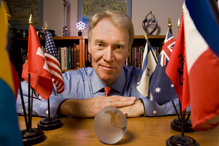
It hardly sounds like the kind of mid-career move a successful engineering professor would pursue – a hectic year at the U.S. Department of State surrounded by people who many feel epitomize Washington’s culture of politics and bureaucracy. It’s an environment where seemingly obvious scientific decisions take a back seat to negotiation and consensus building. And perhaps most critical to an academic engineer, the State Department holds no purse strings over coveted research grants.
So it’s a wonder that James Harrington, professor of materials science and engineering at New Brunswick/Piscataway, enthusiastically characterizes his past year as a State Department Jefferson Science Fellow as “life changing.”
In small part, it might have been the rare chance to live in Washington’s swanky DuPont Circle neighborhood, something Harrington could afford only with the generous housing allowance the Carnegie Corporation and MacArthur Foundation gave each fellow. But the true source of fulfillment, he unabashedly admitted, was the opportunity to help our country by providing sound scientific advice to the diplomatic decision-making and policy-setting process. Or put simply, to keep our country safe and prosperous.
A noted expert in lasers and fiber optics, Harrington brought clarity to export licensing decisions around “dual use” technologies – those equally used in military and commercial goods. “There are laser-equipped machines that carve contact lenses, and with slight modifications, could shape missile parts,” he said. Before licensing these kinds of technologies for export, the government needs to ensure safeguards to block such modifications, he said. Harrington also reviewed technologies involving photo detectors, such as those used in night vision cameras, and superconductors employed in powerful magnets for scientific instrumentation and high-energy physics research.
The State Department established its Jefferson Science Fellows program in 2004, realizing that a better understanding of science and technology would help formulate government policy. It extends a handful of fellowships each year to tenured scientists and engineers from American universities after evaluating their professional reputations, along with ability to articulate scientific issues and participate in policy discussions. During their year at the State Department, the professors’ home institutions agree to pay their salaries and guarantee their positions upon return. Harrington was in the second class of fellows, joined by four others from the University of California at Irvine, the University of Illinois at Urbana–Champaign, the University of North Carolina at Chapel Hill, and Purdue University.
In spite of the State Department’s rhetoric about building scientific expertise, Harrington is quick to note that it has never lacked access to technology experts
“There are plenty to choose from in Defense and Commerce, but those departments have their own agendas,” he said. “If Defense called the shots, technology that benefits humankind might never see light of day. If Commerce had its way, they’d throw caution to the wind to maximize American business. The Jefferson Science Fellows give the State Department its own unbiased experts who weigh both sides of the issue.”
Harrington said it was challenging to gain the trust of state career employees and Foreign Service Officers. Yet by respecting their culture and not charging in with grandiose ideas, Harrington found himself appointed within six months of his arrival to chair an important committee, the technical working group on lasers. In that job, he participated in meetings of the Wassenaar Arrangement, a group of 40 nations that establishes export controls for dual-use technologies.
“Laser technology had already been controlled, but this was the first time the parties reviewed those controls in 15 years,” he said. Wassenaar Arrangement meetings take place three times a year in Vienna, Austria, where Harrington said he learned a lot about diplomacy. “This is a consensus arrangement – not a majority vote. Everyone must agree,” he said. That was challenging, he noted, when the group weighed controls for industries where a participating country’s industrial economy rides almost solely on that sector.
Another State Department effort to which Harrington contributed was review of nonimmigrant visa applications. The department often asked him to investigate people wanting to study or do research in fields, such as cryptography or nuclear engineering, where he knew what questions to ask. More often than not, his efforts helped talented people who felt hamstrung by the process to gain entry versus blocking people whose presence appeared to be a threat.
Now that Harrington is back at Rutgers, he will continue to consult for the State Department for the next five years, a stipulation of the fellowship program. Along with that, he wants to spread word among his colleagues about how valuable the experience is for the university. “My presence in the State Department heightened the government’s awareness of Rutgers,” he said. “But more important, it showed the government what Rutgers can do to help keep our country safe and promote the well-being of others.”